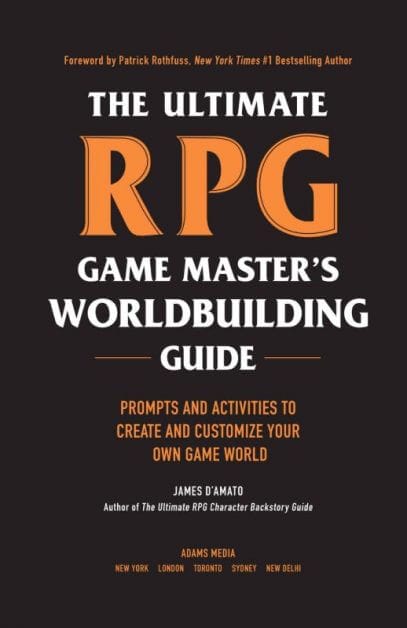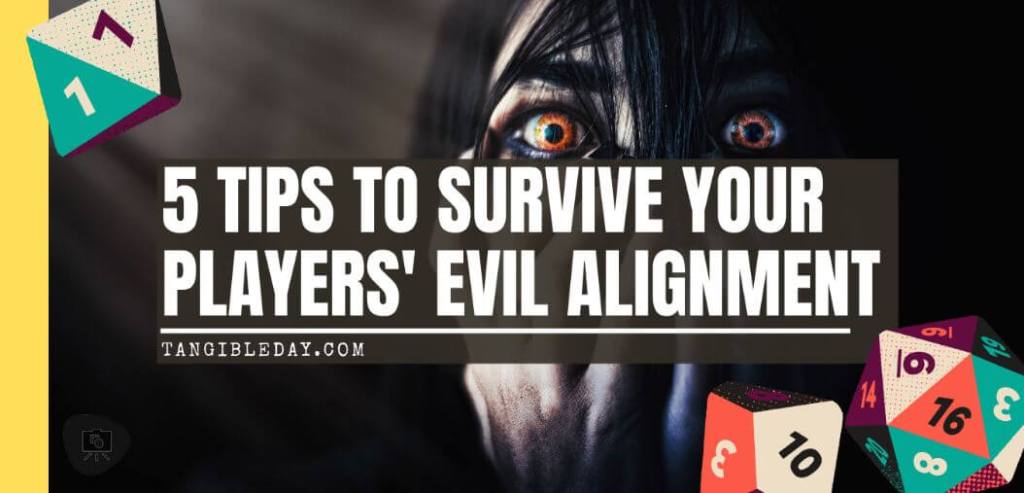So your players want to be “evil aligned murder hobos”, what do you do? How can you enjoy a game where your players’ just want to maim, pillage, and burn your carefully prepared world? These tips will help everybody enjoy the fantasy fun at your tabletop roleplaying game. If you’re running games for Dungeons and Dragons, Pathfinder, or any other RPG, this article is for you!
In this guide, Jared Emanuel shows you how to Game Master (GM) a roleplaying game with evil-aligned players and not suffer burnout.
What is an “Evil-Aligned Character” in Roleplaying Games?
I’ll use the most popular tabletop roleplaying game, Dungeons and Dragons (or D&D) as an example of “evil-alignment” in player characters. In D&D, evil players may be “lawful evil”, “neutral evil”, or “chaotic evil”.
READ MORE: IMMERSIVE AMBIENT LIGHTING TIPS FOR YOUR RPG CAMPAIGN
- Lawful evil players sees the rules and order within the game world as better to exploit, than to follow and obey.
- A neutral evil player may be selfish, and have no issue with backstabbing an ally a moment’s notice for personal gain. They will also have no guilt when harming others to achieve a certain goal. However, a neutral evil aligned character will not go out of their way to perform acts of evil for evil’s sake. Rather, evil is an ideal to follow and leverage for one’s needs, wants, and desires.
- A chaotic evil player will have no respect for any rules, other people’s lives, or anything but their own cruel desires. They seek out personal freedom without regards for the same ideals for others. It is clear that chaotic evil players don’t work well in groups because they resent obedience and cooperative actions unless there is no other choice. It is the chaotic evil player that a GM will have the most trouble running a campaign for with other gamers.
Read on to learn more about how to GM a game with evil aligned players and still have an enjoyable time!

5 Tips for Handling Evil-Aligned Player Characters in Your RPG World
1. Get to Know Your Players, Thoughts and Actions
As a GM, I would recommend that you only engage in a campaign with evil-aligned Player characters that are real life friends. Strangers that you meet online, and pick up games (i.e., D&D Adventurer Leagues) may create tension that is not conducive to this style of play. If the gaming group started out as estranged but evolves into actual friendships, maybe consider preparing this style of campaign. The Players need to trust their GM and vice versa.
Ultimately, it is also important to determine what type of action(s) that the Players will take. For example, they may want to have it all, and decide to take out every town guard in a given city. This may not work for you as the game master. On the other hand, if they just want to steal everything from every shop that isn’t nailed down, or perhaps burn a few buildings, this could be more palatable. Look it’s your game! Any evil-aligned approach should work as long as everybody involved is in agreement about what the rules of engagement are. Bottomline: the goal of every participant should be to leave the table with a smile. 😇
2. Session Zero: Have a Conversation About What to Avoid at the Table
During session zero, have a conversation about what expectations and sensitive topics should be avoided at the table. Stating your limits and learning the limits of your players will help keep everyone comfortable. During character creation, the GM should strongly encourage that their characters have strong ties to each other. Inventing familial ties is an easy way to achieve this, but there are certainly other ways. The “love”, “respect” or “fealty” your characters should feel for each other should be a strong glue to keep them from immediately stabbing each other in the back.
If one of your players wants their character to be especially villainous, try explaining to them why it might not be fun for other players. Many people view being a villain as an end goal unto itself, but if everyone is enjoying themselves then nobody should feel left out! Maybe encourage them to play a rival villain character instead, or try to refocus their energy into being an anti-hero.
3. Debate the Nature of Good vs. Evil
You and your players probably did not sign up for philosophy class. However, a conversation about the ethics of what is good or evil should definitely happen. Evil might mean different things to different people, so it is important to arrive at an accepted definition of Evil when moving forward. An equally important discussion to have with players is: how can Evil be defeated? This will help you as the GM create dynamic encounters. Is the answer to defeat Evil just the expression of love, or doing something in the face of it, or is Evil self-defeating?
Perhaps the source of Evil is a god-like entity that seeks to oppose the source of Good? Maybe Evil is derived from selfish and base instincts of people trying to survive? Or is Evil an unjust imposition of will and strength on the weak? The answers are up for debate, and it is ok if by the end of this discussion you don’t have a clear answer. But, knowing what the players think about Good and Evil will familiarize you as a GM of your players’ perspective of in game behavior, which will help you prepare for impact.
4. Challenge the Characters to Grow
When I started my first Evil Campaign I told my two Lawful Evil Orc Champions two things:
- I was going to try and “out Evil them”
- The campaign was going to end once they both turned good or betrayed each other
I don’t know if I meant these two things. But, I knew that I was intentionally throwing down the gauntlet. I was challenging my players to stick together, have goals, and aim for character growth.
Starting them off at level one meant they were not automatically the baddest dudes on the block. If they wanted to succeed then they needed to struggle, hustle and backstab their way to the top. Their characters had ambition to lead, so they needed to exercise those tyrant muscles first.
5. Deep Down They Want to Be Heroes
It’s a pretty common idea that Evil people believe that they are actually the good guys. Players that want to kill every town guard or overthrow the government or steal from the masses want to transgress against systems that are oppressive and uncaring. So, in response as the GM, I created a World setting ruled by a tyrannical regime.
I placed my players in a world with a frightening government and a brutal society. This would allow them to combat the Evil Laws that society was telling them was “Good”, and replace it with whatever they wanted. I gave them an easy way to feel as if their evil characters were the good guys in their own story.
For example, in my game, the rich king was evil. Through investigation and exploration of his dungeon my players will discover some incriminating evidence that proved he was a tyrant. So, as the GM, what do you do? You can try to sway your players away from trying to overthrow the government, or turn them into the heroes.
So, essentially, I confess: in my evil campaigns, I cheat. I still made my players the Heroes even though they expressly asked to be the Villain. But don’t blame me, because everybody should know to never trust the smiling GM. 😈
Conclusion
Managing an evil campaign is a difficult task for any DM. You need to give players the opportunity to explore their dark fantasies, but also keep them from going off the rails with destructive behavior or ruining your carefully crafted world in one fell swoop.
It is possible to enjoy an evil campaign. The key is to remember that it’s just a game and focus on the fun of playing with friends, even if their characters are being jerks or they’re making you mad by burning down your world!
Have any additional strategies for keeping everyone happy in your RPG campaign? Let us know in the comments below!
About the Author

Jared Emanuel is a hobby enthusiast that loves high fantasy, science fiction, and everything in between.

Pingback: 5 Tips for How to GM a Fun Villain: No Such Thing as An Evil Genius - Tangible Day
I particularly liked where you said that the campaign ends when they betray each other–the player betrayal thing is the main problem I’ve seen in evil games where they quickly fall apart.